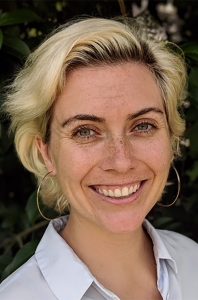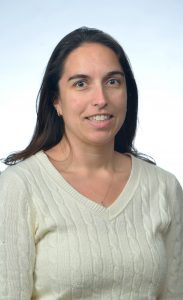
Vanessa Parks, a postdoctoral research associate at the UM Center for Population Studies, is part of a multiuniversity project exploring the effects of freshwater inputs into coastal Louisiana salt marsh ecosystems and the resulting impacts on the recreational fishing industry. Submitted photo
OXFORD, Miss. – A pair of University of Mississippi researchers are members of a multiuniversity project exploring the effects of freshwater inputs into coastal Louisiana salt marsh ecosystems and the resulting impacts on the recreational fishing industry.
Vanessa Parks and Stephanie Otts are working with colleagues at Louisiana State University, Rhodes College and the University of Central Florida on the project. The undertaking is one of six new projects funded by the Gulf Research Program of the National Academies of Sciences, Engineering and Medicine to improve the understanding of how natural processes and human activities interact to affect coastal ecosystems along the Gulf Coast.
“What makes this project unique is its attention to the human dimensions of these ecosystems,” said Parks, a postdoctoral research associate at the UM Center for Population Studies. “For example, the team will combine food web modeling, citizen science, legal research, surveys with the recreational fishing community and spatial analysis of socioeconomic vulnerability in the region to explore how changes to the environment affect marine life and how the recreational fishing community has responded to those changes.
“While there are distinct, disciplinary components to the project, we plan for these efforts to come together to tell us a bigger story about how we interact with and respond to environmental shocks and stressors.”
Titled “Panacea or Pandora’s Box: Coastal Restoration and Recreational Fishing Livelihoods in Salt Marshes of Coastal Louisiana,” the project is led by Michael Polito, an associate professor in LSU’s Department of Oceanography and Coastal Sciences.
Supported by the Gulf Research Program of the National Academies of Sciences, Engineering, and Medicine under award No. 200011664, the project is funded for $588,579. Parks and Otts’ work is a nearly $130,000 sub-award of the main award.
“Translating scientific research results into policy is difficult, in part because legal concepts don’t always equate with scientific principles,” said Otts, director of the National Sea Grant Law Center at UM. “This research project is important because legal research will be integrated from the beginning to understand the existing policy landscape within which the larger research efforts are taking place.”
Covering more than 3 million acres – an area as large as Los Angeles County – the coastal wetlands of Louisiana are responsible for providing nearly 1.2 billion pounds of seafood each year.
The salt marshes are a popular destination for sport fishing, too, and the distribution and abundance of the marshes’ fish, such as redfish and speckled trout, are synchronized with freshwater inflow patterns to the wetlands.
What is unclear, though, is how human activities and natural processes may affect those patterns – and the predictability of fishing forecasts. Previous studies have focused on the effects of human activities on salt marshes, but this study will assess how human activities and natural processes interact.
Using model outputs from this project, researchers will be able to better predict how recreational fishing communities are affected by ecological and socioeconomic changes.
Parks and Otts’ research will involve the human side of these processes.

Stephanie Otts, director of the National Sea Grant Law Center, will help integrate legal principles into the research project. Photo by Nathal Latil/Ole Miss Digital Imaging Services
Otts’ team will examine federal and state laws to inventory the use of the term “fishing community,” as federal law requires that these communities be included in the development of fishery management plans so that adverse economic impacts to these communities are minimized. But the term is inconsistently defined and used, so some of these communities are excluded from consideration.
A working definition of a “fishing community” based on legal precedents will be a useful tool for policymakers, advocates and the communities themselves.
“This project presents an opportunity to better understand how the term ‘fishing community’ is used in federal and state law and whether those definitions adequately reflect the recreational fishing community in Louisiana,” Otts said.
A team lead by Parks will conduct surveys in the recreational fishing community in and around Plaquemines Parish in Louisiana to explore how they have navigated changes such as freshwater inputs, the Deepwater Horizon oil spill and the COVID-19 pandemic. The survey will help researchers to better understand how communities with close ties to the Gulf have adapted to threats in the past and how they view current issues in the Gulf.
“We hope that developing a working legal definition of ‘fishing community’ can help guide policymakers when making decisions about fishery management and coastal restoration,” Parks said. “And by surveying members of the recreational fishing community in a region facing numerous challenges – freshwater inputs, coastal land loss and the pandemic, just to name a few – we hope to document the experiences and adaptations of people with close ties to the Gulf.”
Parks’ interests in fishing communities began while she was working on her dissertation research at LSU, where she earned her doctorate in sociology.
“Fishers face unusual challenges in the midst of environmental change, not only because of their occupational ties to the health of the environment, but also because their way of life is shared intergenerationally and is so richly ingrained in their identity,” she said. “Therefore, disturbances to the environment may be particularly traumatic.
“In my research more generally, I am interested in how places shape a person’s life. This could involve the physical, natural environment as well as the social environment. Fishing communities provide a case where the natural and social environments interact.”
The six Gulf Research Program grants total $5.27 million, and the funding focus for the projects originated from a 2018 National Academies of Sciences, Engineering, and Medicine report, “Understanding the Long-Term Evolution of the Coupled Natural-Human Coastal System: The Future of the U.S. Gulf Coast.” The projects are designed to support scientific research to inform decision-making and natural resource management actions along the Gulf Coast.
The projects concentrate on at least one specific interaction between humans and their environment and how it affects a particular component of Gulf Coast ecosystems.
“In order to make informed decisions that ensure the U.S. Gulf Coast region remains resilient – and habitable – for future generations, we need to understand much better the connections between natural processes and human activities in the region,” said Laura Windecker, program officer for the Gulf Research Program.
“This grant opportunity encourages research that is actionable to help conserve our valuable ecosystems, while also protecting people’s health and livelihood.”
The content of this news release is solely the responsibility of the authors and does not necessarily represent the official views of the Gulf Research Program or the National Academies of Sciences, Engineering and Medicine.